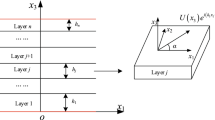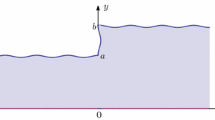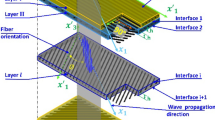Abstract
The acoustic dispersion properties of monodimensional waveguide filters can be assessed by means of the simple prototypical mechanical system made of an infinite stack of periodic massive blocks, connected to each other by elastic joints. The linear undamped dynamics of the periodic cell is governed by a two degree-of-freedom Lagrangian model. The eigenproblem governing the free propagation of shear and moment waves is solved analytically and the two dispersion relations are obtained in a suited closed form fashion. Therefore, the pass and stop bandwidths are conveniently determined in the minimal space of the independent mechanical parameters. Stop bands in the ultra-low frequency range are achieved by coupling the stacked material with an elastic half-space modelled as a Winkler support. A convenient fine approximation of the dispersion relations is pursued by formulating homogenised micropolar continuum models. An enhanced continualization approach, employing a proper Maclaurin approximation of pseudo-differential operators, is adopted to successfully approximate the acoustic and optical branches of the dispersion spectrum of the Lagrangian models, both in the absence and in the presence of the elastic support.









Similar content being viewed by others
References
Acar G, Yilmaz C (2013) Experimental and numerical evidence for the existence of wide and deep phononic gaps induced by inertial amplification in two-dimensional solid structures. J Sound Vib 332:6389–6404
Bacigalupo A, Gambarotta L (2017) Dispersive wave propagation in two-dimensional rigid periodic blocky materials with elastic interfaces. J Mech Phys Solids 102:165–186
Bacigalupo A, Gambarotta L (2019) Generalized micropolar continualization of 1D beam lattices. Int J Mech Sci. https://doi.org/10.1016/j.ijmecsci.2019.02.018
Baravelli E, Ruzzene M (2013) Internally resonating lattices for bandgap generation and low-frequency vibration control. J Sound Vib 332:6562–6579
Beli D, Arruda JRF, Ruzzene M (2018) Wave propagation in elastic metamaterial beams and plates with interconnected resonators. Int J Solids Struct 139:105–120
Bhaskar A (2009) Elastic waves in Timoshenko beams: the ‘lost and found‘of an eigenmode. Proc R Soc A 465:239–255
Brillouin L (1946) Wave propagation in periodic structures. McGraw-Hill, New York
Brun M, Giaccu GF, Movchan AB, Movchan NV (2012) Asymptotics of eigenfrequencies in the dynamic response of elongated multi-structures. Proc R Soc A 468:378–394
Carta G, Jones IS, Movchan NV, Movchan AB, Nieves MJ (2017) Gyro-elastic beams for the vibration reduction of long flexural systems. Proc R Soc A 473:20170136
Chen Y, Wang L (2015) Bio-inspired heterogeneous composites for broadband vibration mitigation. Sci Rep Nat 5:17865
Craster RV, Guenneau S (eds) (2012) Acoustic metamaterials. Springer, London
Cummer SA, Christensen J, Alù A (2016) Controlling sound with acoustic metamaterials. Nat Rev Mater 1:1–13
Deng B, Wang P, He Q, Tournat V, Bertoldi K (2018) Metamaterials with amplitude gaps for elastic solitons. Nat Commun 9:3410
Deymier PA (ed) (2013) Acoustic metamaterials and phononic crystals, vol 173. Springer, Berlin
Frandsen NM, Bilal OR, Jensen JS, Hussein MI (2016) Inertial amplification of continuous structures: large band gaps from small masses. J Appl Phys 119(12):124902
Gei M, Movchan AB, Bigoni D (2009) Band-gap shift and defect-induced annihilation in prestressed elastic structures. J Appl Phys 105:063507
Habermann MR, Norris AN (2016) Acoustic metamaterials. Acoust Today 12:31–39
Huang GL, Sun CT (2010) Band gaps in a multiresonator acoustic metamaterial. J Vib Acoust 132:031003
Hussein MI, Leamy MJ, Ruzzene M (2014) Dynamics of phononic materials and structures: historical origins, recent progress, and future outlook. Appl Mech Rev 66(4):040802
Jordan C (1965) Calculus of finite differences, vol 33. American Mathematical Society, Providence
Kelley WG, Peterson AC (2001) Difference equations: an introduction with applications. Academic Press, New York
Ma G, Sheng P (2016) Acoustic metamaterials: from local resonances to broad horizons. Sci Adv 2:1501595
Maslov VP (1976) Operational methods. Mir, Moscow
Matlack KH, Serra-Garcia M, Palermo A, Huber SD, Daraio C (2018) Designing perturbative metamaterials from discrete models. Nat Mater 17:323
Miniaci M, Krushynska A, Movchan AB, Bosia F, Pugno NM (2016) Spider web-inspired acoustic metamaterials. Appl Phys Lett 109(7):071905
Miniaci M, Krushynska A, Gliozzi AS, Kherraz N, Bosia F, Pugno NM (2018) Design and fabrication of bioinspired hierarchical dissipative elastic metamaterials. Phys Rev Appl 10(2):024012
Piccolroaz A, Movchan AB (2014) Dispersion and localisation in structured Rayleigh beams. Int J Solids Struct 51:4452–4461
Rota GC, Kahaner D, Odlyzko A (1973) On the foundations of combinatorial theory VIII: finite operator calculus. J Math Anal Appl 42:684–760
Shubin MA (1987) Pseudodifferential operators and spectral theory. Springer, Berlin
Taniker S, Yilmaz C (2015) Design, analysis and experimental investigation of three-dimensional structures with inertial amplification induced vibration stop bands. Int J Solids Struct 72:88–97
Vasseur JO, Deymier PA, Chenni B, Djafari-Rouhani B, Dobrzynski L, Prevost D (2001) Experimental and theoretical evidence for the existence of absolute acoustic band gaps in two-dimensional solid phononic crystals. Phys Rev Lett 86:3012
Wang XQ, So RMC (2015) Timoshenko beam theory: a perspective based on the wave-mechanics approach. Wave Motion 57:64–87
Yilmaz C, Hulbert GM, Kikuchi N (2007) Phononic band gaps induced by inertial amplification in periodic media. Phys Rev B 76:054309
Yin J, Huang J, Zhang S, Zhang HW, Chen BS (2014) Ultrawide low frequency band gap of phononic crystal in nacreous composite material. Phys Lett A 378:2436–2442
Yin J, Peng HJ, Zhang S, Zhang HW, Chen BS (2015) Design of nacreous composite material for vibration isolation based on band gap manipulation. Comput Mater Sci 102:126–134
Acknowledgements
The authors acknowledge financial support of the (MURST) Italian Department for University and Scientific and Technological Research in the framework of the research MIUR Prin15 project 2015LYYXA8, Multi-scale mechanical models for the design and optimization of micro-structured smart materials and metamaterials, coordinated by prof. A. Corigliano. The authors also thankfully acknowledge financial support by National Group of Mathematical Physics (GNFM-INdAM).
Author information
Authors and Affiliations
Corresponding author
Ethics declarations
Conflict of interest
The authors declare that they have no conflict of interest.
Additional information
Publisher's Note
Springer Nature remains neutral with regard to jurisdictional claims in published maps and institutional affiliations.
Appendices
Appendix 1: The sixth order PDE governing the equivalent homogenized model
By applying the enhanced continualization procedure presented in Sect. 3 to the system of Eqs. (17) governing the motion of the block, a system of two PDEs is obtained, whose order depends on the order of truncation applied. Here, the equations derived by retaining terms up to the sixth order are given, having the following form
Lower order formulations are derived retaining terms of fourth and second order, the latter being given in Eq. (20). It is worth to note that also for the higher order model the condition for the positive definiteness of the elastic potential energy turns out to be \(r_{k} r_{b}^{2} \left( {1 + \frac{{r_{kw} }}{{6r_{b}^{3} }}} \right) > 1.\)
Appendix 2: Standard continualization
Let us consider a standard continualization of (17) through the introduction of the shift operator previously introduced. The pseudo-differential problem of equilibrium for the i-th block takes the form
By expanding in a Taylor series the pseudo-differential operators a PDE system is obtained. In case the expansion is truncated to the fourth order one obtains
and the corresponding elastic potential energy density turns out to be
The elastic potential energy density turns out to be positive defined for values of the ratios such that \(r_{k} r_{b}^{2} > 5\), which is more restrictive than the corresponding one obtained through the enhanced homogenization \(r_{k} r_{b}^{2} \left( {1 + \frac{{r_{kw} }}{{6r_{b}^{3} }}} \right) > 1\) related to the differential problem (20).
Rights and permissions
About this article
Cite this article
Bacigalupo, A., Gambarotta, L., Lepidi, M. et al. Acoustic waveguide filters made up of rigid stacked materials with elastic joints. Meccanica 54, 2039–2052 (2019). https://doi.org/10.1007/s11012-019-00959-8
Received:
Accepted:
Published:
Issue Date:
DOI: https://doi.org/10.1007/s11012-019-00959-8




